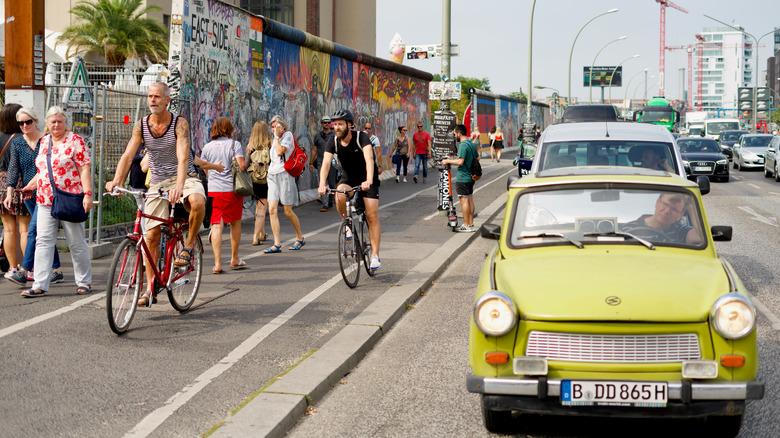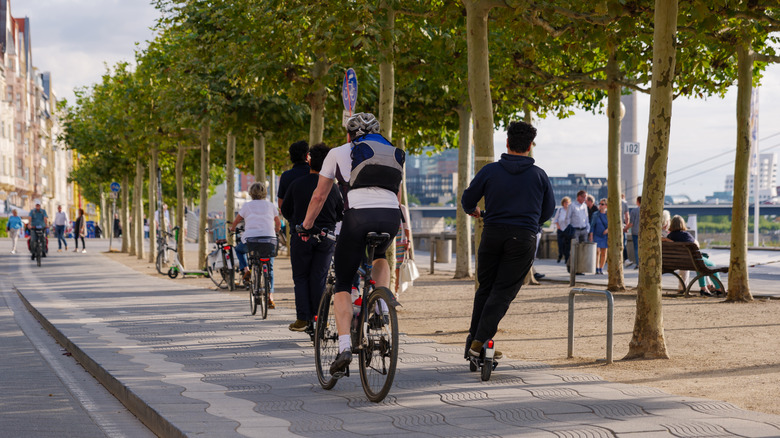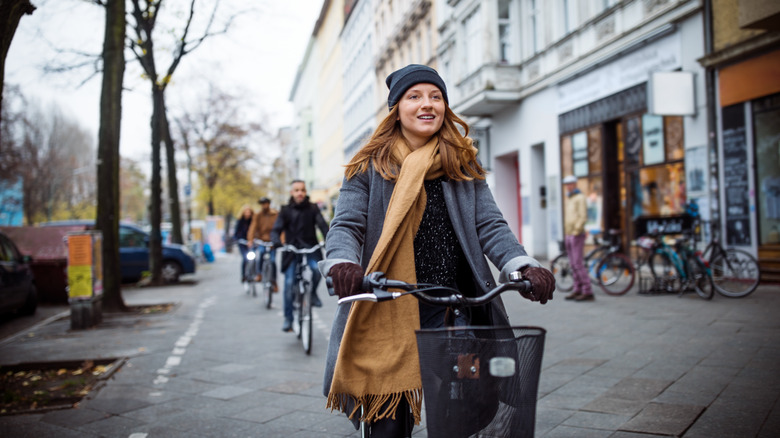Locals Hate When Tourists Make This Dangerous Mistake While Walking Around Germany
Picture the scene: You're taking a pleasant stroll through the streets of a German city, taking in the sights and the atmosphere. Suddenly, your walk is abruptly interrupted by a cyclist zooming past, perhaps close enough to brush against you, furiously ringing their bell. Watching the bike speed into the distance as other pedestrians dutifully step to one side, you realize your mistake. You have ventured onto the wrong side of the pavement and into the bike lane.
German people are generally welcoming, tolerant, and polite, but they also have a reputation for directness and can be sticklers about the rules. One way to turn smiles into frowns is to breach the rules of the sidewalk. Ambling in the wrong lane is a common visitor's mistake, but don't expect too much sympathy from other walkers if you get buzzed by a cyclist. It can be dangerous and drive the locals mad.
Germany is one of several European countries that has invested in infrastructure to make cycling an attractive option for citizens, allocating 2.4 billion Euros (around $2.6 billion) towards its National Cycling Plan. The benefits include providing for eco-friendly travel, reducing road accidents, and improving people's health and well-being. One side-effect of this admirable policy is that, in certain areas, pedestrians find themselves sharing pavement space with cyclists. In most cases, it is harmonious, but it is worth knowing the rules before you set out for a walk on German streets.
What to know about German shared footpaths and cycleways
There is a very clear set of rules for cyclists in Germany to maximize their safety and that of everyone else on the street. These include only one person per bike, always wearing helmets, and never riding while inebriated, to name a few. A bicycle is defined as a vehicle that belongs to the road, although children younger than 8 should ride on the sidewalk. There are exceptions to the rule, however, which may confuse visitors. While there are marked cycle lanes on the roads, shared footpaths where cyclists may ride alongside pedestrians are also provided.
While the rules are relatively straightforward, signage and the way these shared spaces are marked may not be immediately obvious to a visitor. Both shared footpaths and cycleways next to a footpath are indicated by a blue circle sign containing a pedestrian symbol and a bicycle symbol. The only difference is that the former is divided by a horizontal line and the latter by a vertical line.
In practice, this significantly alters pavement etiquette. On a shared footpath, pedestrians should keep an eye out for bikes, but cyclists must respect the walkers' right of way. With cycleways adjacent to footpaths, pedestrians are warned to stay out of the cyclist's half for everyone's safety. An accidental collision between a bicycle and an oblivious walker is bad news for both parties.
How to tell which side of the sidewalk to use in Germany
The best way to avoid potentially dangerous confrontations with cyclists while exploring Berlin or another German city is to take a "When in Rome" approach. Ignorance of the rules is no excuse, and you'll enjoy your stroll more if you know what to look out for.
Keep a look out for the signs so you know what type of footpath you are walking on, and pay attention to what is happening around you. Locals walk on the right-hand side of the pavement, furthest away from the road. Looking down, you may notice that the sidewalk is divided, although this is sometimes clearer than at other points. In Cologne, the two sides are distinctly different colors with grey for pedestrians and red for cyclists. It isn't quite as obvious in parts of Berlin where both sides are shades of gray, differentiated only by the central dividing line and shape of paving slabs.
It's also worth crossing the line and becoming a cyclist yourself when visiting European cities that are well-suited to bikes. The Netherlands is historically a country of cyclists and rentals or e-bikes are one of the best ways to get around Amsterdam. Vienna is another city that is a joy to roam on two wheels and has a well-integrated bike rental system. Just keep an eye out for those pedestrians and go a little easy with the bell if one gets in your way.


